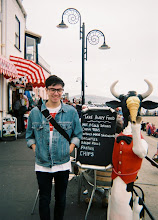It began to occur to me that using a mini dv camera for the video aspect of a project which began with a holga, old polaroid camera and instant film didn't quite add up. As the approach I started out with was using simple, out-dated technology so as to produce a physical object, using a video camera whereby the end product is a well-controlled, well-exposed image in the form of a piece of digital encoding didn't quite seem to fit.
I thought back to a product I had seen a few months ago, The Harinezumi digital video camera(below).
I thought back to a product I had seen a few months ago, The Harinezumi digital video camera(below).

This camera is a small, compact and fairly low-tech approach to video, from Superheadz, in the same vein as the Holga or Diana. The Harinezumi's aesthetics are dream-like, with a strong emphasis on the "artless" over the perfected image. With only a 2mp CCD sensor the images lack the definition and contrast of a more typical video camera yet have a charm of their own. Even the LCD screen which usually comes as standard is discarded when shooting on the Harinezumi camera, instead relying on a small square plastic view-finder which pops up just above the lens, in a similar design to the Ikimono 110 cameras (below). Below is an example of the kind of footage the Harinezumi captures.


Not ony do the Harinezumi's images harken back to earlier 8mm film stock, (traditionally used to capture family movies) just like 8mm film sound is absent. I feel that using this camera would be useful to my work but I didn't feel I could justify spending over a hundred pounds on such a low-tech camera. Instead I began to research alternative ways of getting a 'low-tech' and ultimately outdated look to my film, relying on the medium over cheap after effects in Finalcut. I then discovered that both 8mm and Super 8 film were still available to buy and develop. Though development costs are fairly high the initial start-up for the equipment- camera, projector and film splicer- were relatively cheap.
I intend to use Super 8 film over 8mm as, though both offer the warmly-toned grainy images Super 8 has a larger film area, magnetic sound-strip and creates a direct film strip over the colour-negative of the 8mm, which then requires a print to be made of it before it can be projected. This also links to my original polaroid idea of the intangible becoming a physical object.(below: upper-Super 8 film. lower- 8mm film.)



No comments:
Post a Comment